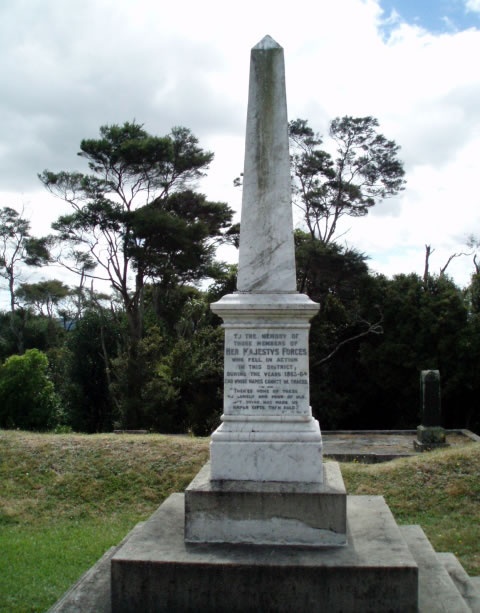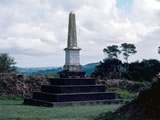
The remains of Alexandra Redoubt, located near the Waikato town of Tūākau, occupy a commanding position 90 m above the right bank of the Waikato River. This memorial obelisk stands near the entrance to the site. It is dedicated to the imperial and colonial troops, known and unknown, who died in the Franklin district in 1863–64.
Founded in 1840, Tūākau was originally a flax-milling centre with a good landing place on the Waikato River. In July 1863, soon after Governor George Grey ordered the invasion of Waikato, a detachment of the 65th Regiment led by Lieutenant-Colonel Alfred Wyatt fortified the high ground overlooking the Tūākau landing.
Alexandra Redoubt covered about one-third of a hectare. The rectangular fortification featured flanking bastions on diagonally opposite corners. It was named after the popular Danish princess who, in March 1863, married the Prince of Wales (later King Edward VII). By September 1863, the redoubt was garrisoned by 150 troops of the 65th under Captain Richard Swift.
Of great strategic importance, Alexandra Redoubt was intended to safeguard Lieutenant-General Duncan Cameron’s right flank on the Waikato River. It protected the British naval fleet that transported troops and provisions for the Waikato campaign, and helped to secure the South Auckland region against Kīngitanga forces.
Alexandra Redoubt became part of a river-based British supply chain that was operational by mid-August 1863. Provisions were brought from Onehunga to the Waikato Heads by steamer. They were then transferred to smaller vessels and taken upriver to Queen’s Redoubt at Pōkeno, the British military headquarters for the Waikato invasion.
Camerontown was the halfway point in this supply chain. Named after Lieutenant-General Cameron, this army depot was situated a few kilometres downstream from Alexandra Redoubt. It was protected by pro-government Ngāti Whauroa.
On the morning of 7 September 1863, Camerontown was ransacked by a party of some 100 Kīngitanga, mostly Ngāti Maniapoto, fighters. The raiders then surprised reinforcements sent from Alexandra Redoubt, 50 troops led by Captain Swift. In the skirmish near Camerontown that followed, Swift and three other men were killed and the second-in-command, Lieutenant Butler, wounded. Colour Sergeant Edward McKenna assumed command, leading the detachment back to the redoubt the following morning.
Several troops were decorated as a result of their actions. McKenna and Lance-Corporal (possibly Private) John Ryan were awarded the Victoria Cross. Sergeant (possibly Corporal) J. Bracegirdle and Privates William Butford, Talbot, J. Cole and B. Thomas were awarded the Distinguished Conduct Medal.
McKenna survived the New Zealand Wars and went on to have a career with the Railways Department. However Ryan never received his VC. He drowned in the Waikato River just over three months later while attempting to save a comrade.
Thanks largely to the efforts of Edith Statham, the Inspector of Old Soldiers’ Graves in the Department of Internal Affairs, the New Zealand government erected this memorial some 50 years after the engagement at Camerontown. John Bouskill completed the work in June 1915 at a cost of £27 10s. Additional inscriptions were added in September 1916 to make up the four faces seen today. The spectre of the First World War is evident in one of the inscriptions, which includes an extract from Rupert Brooke’s poem, ‘1914 III: The Dead’.
George Russell, the Minister of Internal Affairs, unveiled the memorial on the afternoon of 9 December 1916. Among the New Zealand Wars veterans attending the ceremony was Major Brown, who had at one time commanded Alexandra Redoubt.
In December 1916, probably after the unveiling, the upper section of the memorial was rotated so that the main inscription faced the front. This explains why the inscription on the memorial’s base, ‘Erected by the N.Z. Government 1915’, appears on a different face in the archival image.
James Berry is one of three servicemen recorded on the memorial as a ‘veteran’ of the New Zealand Wars. This suggests that he, along with the other named veterans, Esau Gale and Joseph Davies, died after the New Zealand Wars ended in 1872.
Down the hill from the redoubt, Alexandra Redoubt (Historic) Cemetery contains Berry’s grave, along with those of Stephen Grace and John Williams. These plots were given headstones by the Ministry for Culture and Heritage in 2007.
Tūākau’s Alexandra Redoubt should not be confused with the redoubt built in the north Waikato military settlement of Alexandra, now known as Pirongia. The settlement of Alexandra was founded in 1864 when Colonel Theodore Haultain (later the Minister of Defence) landed at Pirongia from the Waikato River with his militia.
Pirongia’s Alexandra Redoubt was built in 1869 and rebuilt three years later. It was garrisoned by the Armed Constabulary (later the Constabulary Field Force) until 1886 and restored in the late 20th century.
Images
Images from c. 1986
Image from 1915 or 1916
Transcript
Front face:
This monument / marks the site of the / Alexandra Redoubt / an important base of / Her Majesty’s troops / during the Maori War / 1863–64. / Erected / by the N.Z. Government / 1915
Face [A]:
To the memory of / those members of / Her Majesty’s forces / who fell in action / in this district / during the Years 1863-64 / and whose names cannot be traced / “There's none of these / so lonely and poor of old, / But, dying, has made us / rarer gifts than gold.”
Face [B]:
In memory of / Stephen Grace / John Ryan / John Frost / Edward Bryant / McLean / Richard Bellringer / all of 65th Regiment / John Williams / 2nd 14th Regiment
Face [C]:
Veterans / Esau C. Gale / James Berry / Joseph Davies
J[ohn]. Bouskill [the memorial’s designer and builder]
Further information
- James Belich, ‘The invasion of the Waikato’, in The New Zealand Wars and the Victorian interpretation of racial conflict, Penguin, Auckland, 1998, pp. 119–41
- James Cowan, ‘How Sergeant Mckenna won the Victoria Cross: a night in the Maori bush’, in Hero stories of New Zealand, Harry H. Tombs, 1935, pp. 69–77
- James Cowan, ‘The first engagements’, in The New Zealand Wars: a history of the Maori campaigns and the pioneering period: volume I: 1845–1864, R.E. Owen, Wellington, 1955, pp. 251–64
- B.N. Davis and E.S. Dollimore, ‘Tuakau’, in A.H. McLintock (ed.), An Encyclopaedia of New Zealand, Government Printer, 1966, republished by Te Ara: the encyclopedia of New Zealand, updated 22-Apr-09
- ‘Dominion News’, Ashburton Guardian, 11 December 1916, p. 2
- Image: The Alexandra Redoubt, Tuakau (NZETC)
- Chris Maclean and Jock Phillips, The sorrow and the pride: New Zealand war memorials, GP Books, Wellington, 1990, pp. 32–8
- Nigel Prickett, ‘The Waikato War, 1863–64’, in Landscapes of conflict: a field guide to the New Zealand Wars, Random House, Auckland, 2002, pp. 69–86








Community contributions